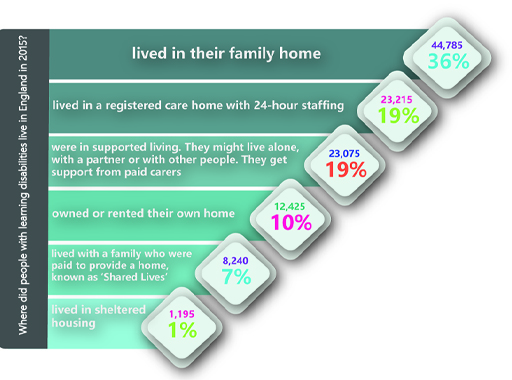6 Where do people with learning disabilities live?
Box _unit2.6.1
In answering this question, you will not consider children as most live with their families.
In 2015, there were 124,000 people receiving long-term support from a local authority in England because they had a learning disability. We know where they live because the state has some responsibility for them. However, we don’t know about the others – no one is counting them.
Because they need support, many of the 124,000 people live in locations where they can access help, from family or from paid staff.
You may have noticed that these figures only add up to 92%, which means we do not have details for where the remaining 8% of people live.
In the next activity you will compare the data from England with that of Wales.
Activity _unit2.6.1 Activity 5 Where do people with learning disabilities live in Wales?
These are the figures for where people with learning disabilities lived in Wales, in 2017/2018:
- Own home: 16%
- With parents or family: 53%
- A foster home: 2%
- Lodgings / supported living: 21%
(We do not have details for where the remaining 8% of people live.)
What are some of the most striking differences between England and Wales?
Discussion
You may have noticed that many more people with learning disabilities live with their families in Wales than in England (61% compared with 36%). The Wales figures do not explicitly show anybody living in a registered care home, which is another big difference compared to England. It is possible that they are included in the lodgings / supported living categories, and some of the small numbers living in health service accommodation, but it is not possible to be sure. This highlights the difficulties in comparing data across different countries.
In this section you have considered how many people have a learning disability, and the sorts of places where they might live as adults.
Given the relatively small number of people with a learning disability supported by local councils (remember there are over one million people living with a learning disability in England), you might wonder why bother to use labels at all. It is this that you will come to next.

